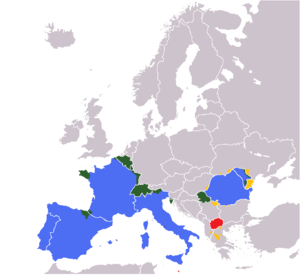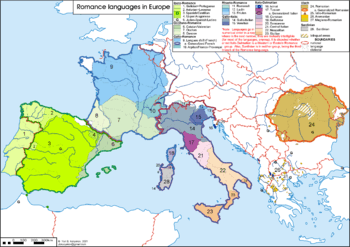Romance-speaking Europe


Romance-speaking Europe, or Latin Europe, is the area of Europe where Romance languages (those derived from Latin) are either official, co-official, or significantly used. It is a major linguistic subdivision of Europe alongside Germanic-, and Slavic-speaking subdivisions.
The Latin European or Romance European countries are Italy, France, Moldova, Portugal, Romania, Spain, Monaco, San Marino, Andorra and the Vatican City. Many of these countries were members of the Latin Union, until it was dissolved in 2012. It also includes some regions from other countries, such as Wallonia in Belgium and the French- and Italian-speaking cantons of Switzerland, Luxembourg where French is co-official, as well as communities from other non-Latin European countries. Some Eastern Romance languages like Aromanian, Megleno-Romanian and Istro-Romanian are spread across the entire Balkans in small communities within Slavic-speaking countries, Greece, and western Turkey. The total population of all the Romance-speaking areas in Europe is approximately 210,000,000, 42% of the European Union's population.
History
The spread of the Roman Empire brought with it Vulgar Latin. After the fall of the empire, this started to break up into different dialects, and eventually, whole separate languages, resulting in the Romance languages of today.
Countries
| Countries / Territories | Romance languages used | Religion | Area | Population | GDP (nominal) | Comments | |
|---|---|---|---|---|---|---|---|
| |
Catalan (official) | Roman Catholic | 468 | 85,082 | 4,510 | — | |
| |
Total (out of included areas) | French (co-official) | Roman Catholic (58%)[1] | 17,005 | 4,407,705 | 514,593 | — |
| |
French | — | 16,844 | 3,376,490 | — | — | |
| |
French (co-official) | — | 161 | 1,031,215 | — | — | |
| |
Total (out of included areas) | — | Roman Catholic (87%) | 56,594 | 4,290,612 | 63,842 | — |
| Istria county | Italian (co-official) Istriot (unofficial) Istro-Romanian (unofficial) | — | 2,820 | 206,344 | — | — | |
| (Metropolitan France) |
French (official) | Roman Catholic (54%)[1] | 551,695 | 63,460,000 | 2,559,850 |
Exceptions:
| |
| |
Spanish (unofficial) | Roman Catholic | 6.8 | 29,431 | 1,106 | As a British overseas territory, it has a sole official language of English even though the vast majority of the population is bilingual together with Spanish. In addition to this the majority of Gibraltarians speak Llanito (an Andalusian Spanish-based creole unique to Gibraltar) as their vernacular. | |
| |
Total (out of included areas) | — | Eastern Orthodox | — | — | — | — |
| — | Aromanian (unofficial) Megleno-Romanian (unofficial) | — | 250,000 4,000 | 299,275 | — | ||
| |
French (unofficial) | — | 78 | 65,573 | 2,742 | Guernsey and Jersey both have various use of French and Norman language, although admittedly in decline. In the case of the Bailiwick of Guernsey, this includes Guernesais and Sercquais. French was an official language of Alderney of Guernsey until the late 1960s. | |
| |
Total (out of included areas) | Italian (official) | Roman Catholic | 301,318 | 60,813,326 | 2,198,732 |
Exceptions:
|
| Aosta Valley | French (co-official) | - | - | - | - | ||
| South Tyrol, Trentino, Veneto | Ladin (co-official) | - | - | - | - | ||
| Alghero | Catalan (co-official) | - | - | - | - | ||
| |
French (co-official) | — | 116 | 97,857 | 5,100 | Jersey and Guernsey both have various use of French and Norman language, although admittedly in decline. In the case of Jersey, this includes Jersey Law French and Jèrriais. | |
| |
French (co-official) | Roman Catholic (87%) | 2,586.4 | 480,222 | 59,582 | — | |
| |
Total (out of included areas) | — | Eastern Orthodox (64.7%) | 25,713 | 2,058,539 | 10,644 | — |
| Kruševo, Skopje, Bitola, Štip | Aromanian (official) | — | — | 10,000 (est.) | — | — | |
| Huma | Megleno-Romanian (unofficial) | — | — | 2,000 (est.) | — | — | |
| |
Italian (unofficial) | Roman Catholic (98%) | 316 | 452,515 | 8,941 | Although Maltese is a Semitic language, a good portion of Maltese vocabulary is Romance, having been imported from Italian, Sicilian, and French.[3][4] | |
| |
Romanian (official) | Eastern Orthodox (93.3%) | 33,846 | 3,559,500 | 7,003 | — | |
| |
French (official) Monégasque (National language) | Roman Catholic (83.2%)[5] | 1.98 | 36,371 | 5,424 | — | |
| |
Portuguese (Official) Mirandese (Regionally Co-Official) | Roman Catholic (84%) | 92,345 km² | 10,642,836 | $232,000,000,000 | - | |
| |
Romanian (Official) | Eastern Orthodox (86.7%) | 238,392 km² | 22,276,056 | $256,900,000,000 |
| |
| |
Italian (Official) | Roman Catholic (97%)[6] | 61 km² | 29,615 | $904,000,000 | - | |
| |
Total (out of included areas) | Romanian (Regionally Co-Official) (Regionally Unofficial) | - | 28636 km² | 60,000 (est.) | $64,000,000,000 | - |
| |
Romanian (Co-Official) | Eastern Orthodox | 21,506 km² | 29,512 | - | - | |
| Timočka Krajina | Romanian (Unofficial) | Eastern Orthodox | 7,130 km² | 25,000 (est.) | - | - | |
| |
Total (out of included areas) | Italian (Regionally Official) | Roman Catholic[7] | 384.4 km² | 78,846 | $47,841,000,000 | - |
| Piran | Italian (Official) | - | 44.6 km² | 16,758 | - | - | |
| Izola | Italian (Official) | - | 28.6 km² | 14,549 | - | - | |
| Koper | Italian (Official) | - | 311.2 km² | 47,539 | - | - | |
| |
Total (out of included areas) | Spanish | Roman Catholic[8] | 505,992 | 47,190,493 | 1,479,560 |
Exceptions:
|
| |
Aragonese (Recognised) Catalan (Recognised) | - | 47,719 km² | 1,277,471 | - | ||
| |
Asturian (Recognised) | - | - | - | - | ||
| |
Catalan (Co-Official) Aranese (Co-Official) | - | - | - | - | ||
| |
Valencian (Co-Official) | - | - | - | - | ||
| |
Catalan (Co-Official) | - | - | - | - | ||
| |
Galician (Co-Official) | - | - | - | - | - | |
| |
Total (out of included areas) | Italian (Regionally Official) (Regionally Co-Official) French (Regionally Official) (Regionally Co-Official) Romansh (Regionally Co-Official) | - | 27906 km² | 3,353,597 | $296,200,000,000 | - |
| |
Italian (Co-Official) Romansh (Co-Official) | Roman Catholic[9] | 7,105 km² | 187,920 | - | - | |
| |
French (Co-Official) | Protestant (67%)[10] | 5,959 km² | 958,897 | - | - | |
| |
French (Co-Official) | Roman Catholic[11] | 1,671 km² | 258,252 | - | - | |
| |
French (Co-Official) | Roman Catholic (81%)[12] | 5,224 km² | 294,608 | - | - | |
| |
French (Official) | Protestants (40%), Roman Catholics (34%)[12] | 3212 km² | 657,700 | - | - | |
| |
French (Official) | Protestants (38%), Roman Catholics (31%)[13] | 803 km² | 168,912 | - | - | |
| |
French (Official) | Protestant, Catholic[14] | 282 km² | 433,235 | - | - | |
| |
French (Official) | Roman Catholic (75%)[12] | 838 km² | 69,222 | - | - | |
| |
Italian (Official) | Roman Catholic[15] | 2,812 km² | 324,851 | - | - | |
| |
Total (out of included areas) | Romanian (Regionally Unofficial) | - | 54,184 km² | 4,533,853 | $364,300,000,000 | |
| |
Romanian (Unofficial) | Eastern Orthodox | 33,310 km² | 2,387,543 | - | - | |
| |
Romanian (Unofficial) | Eastern Orthodox | 12,777 km² | 1,241,887 | - | - | |
| |
Romanian (Unofficial) | Eastern Orthodox | 8,097 km² | 904,423 | - | - | |
| |
Italian (official) | - | 0.44 km² | 821 | - | - | |
See also
- Latin Europe
- Latin America
- Latin Africa
- Latin Arch
- Latin Union
- Latins
- Latin peoples
- Mediterranean Union
- Romance-speaking world
- Romance-speaking Africa
- Romance-speaking Asia
References
- 1 2 "Discrimination in the EU in 2012" (PDF), Special Eurobarometer, 383, European Union: European Commission, p. 233, 2012, retrieved 14 August 2013 The question asked was "Do you consider yourself to be...?" With a card showing: Catholic, Orthodox, Protestant, Other Christian, Jewish, Muslim, Sikh, Buddhist, Hindu, Atheist, and Non-believer/Agnostic. Space was given for Other (SPONTANEOUS) and DK. Jewish, Sikh, Buddhist, Hindu did not reach the 1% threshold.
- ↑ RGP 1999 (exploitation principale), Fichiers SAPHIR, INSEE Alsace (French) (English)
- ↑ Much of the Maltese language comes from other European Languages. Retrieved on 2007-11-22.
- ↑ Malta is sometimes included, as its language relies heavily on Italian imports. Retrieved on 2007-11-22.
- ↑ Joshua Project. "Ethnic People Groups of Monaco". Joshua Project. Retrieved 12 March 2013.
- ↑ World and Its Peoples. Marshall Cavendish. 2009. p. 856. ISBN 0-7614-7893-0.
- ↑ Source: Statistical Office of the Republic of Slovenia, Census of Population, Households and Housing, 2002.
- ↑ "Barómetro Abril 2014" (PDF). Centro de Investigaciones Sociológicas (Centre for Sociological Research). April 2014. p. 26. Retrieved 6 April 2014.
- ↑ Federal Department of Statistics (2008). "Wohnbevölkerung nach Religion, nach Kantonen und Städten" (Microsoft Excel). Retrieved 2008-10-06.
- ↑ Federal Department of Statistics (2004). "Wohnbevölkerung nach Religion" (Interactive Map). Retrieved 15 January 2009.
- ↑ Federal Department of Statistics (2004). "Wohnbevölkerung nach Religion" (Interactive Map). Retrieved 2009-01-15.
- 1 2 3 Federal Department of Statistics (2004). "Wohnbevölkerung nach Religion" (Interactive Map). Retrieved 2009-01-15.
- ↑ Federal Department of Statistics (2004). "Wohnbevölkerung nach Religion" (Interactive Map). Retrieved 2009-01-15.
- ↑ "Statistiques cantonales – Les 21 domaines: 01. Population – Langues et religions" (official website) (in French). Geneva, Switzerland: StatistiqueGenève, République et Canton de Genève. August 2014. Retrieved 2014-12-08.
- ↑ "Population résidante permanente de 15 ans et plus, ventilée selon l'appartenance religieuse et confessionnelle et le canton". Office fédéral de la statistique. 2011. Retrieved 27 August 2013.